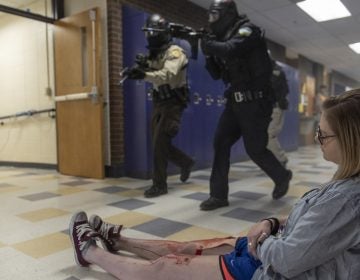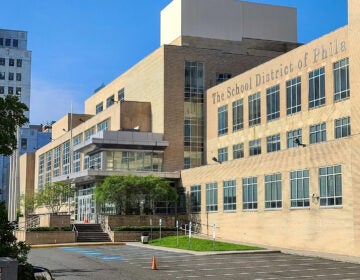School-related threats in Pa. are on the rise; homicides and violent crime decline
While school-related threats of violence are on the rise this academic year, experts caution that it is too early to determine if this upward trend will continue.
Listen 1:04
The hallway of a school in Pennsylvania. (Nate Smallwood for Spotlight PA)
From Philly and the Pa. suburbs to South Jersey and Delaware, what would you like WHYY News to cover? Let us know!
Recent figures indicate a surge in school-related threats of violence across the city, state and country in the early months of this academic year. However, experts caution that it is too early to determine if this upward trend will continue throughout the rest of the year.
According to the School District of Philadelphia, there were 80 school-related threats against students, teachers or schools so far in the 2024-25 school year. If the current pace continues, it could exceed last year’s report of more than 400.
A school district spokesperson declined to comment on the numbers.
State Attorney General Michelle Henry issued a statement to the media last month about rising school-related threats of violence across the commonwealth, most of which she attributed to social media pranks.
Henry said she is reluctant to criminally charge students.
“However, intentional false reports traumatize other students and the school community at large, while hampering overall efforts to keep schools and students safe,” Henry stated via a news release.
According to the Attorney General’s office, the number of school-focused threats of violence to its anonymous tip line, Safe2Say Something, increased by about 50% this school year.
The figures come at a time when the number of homicides in Philadelphia dropped about 40%, compared to the same period in 2023, according to the latest figures from the City Controller’s office.
Nationally, many big cities are reporting similar decreases in homicides and serious crime.
According to the FBI’s most recent 2024 Quarterly Uniform Crime Report, as of Sept. 30, between January and June, in the U.S., homicides were down 22.7%; violent crime dropped by 10.3%; aggravated assault decreased 8.1%; and property crime lowered by 13.1%, compared to the same period in 2023.
Advocates point to more emphasis on community policing; increased spending for violence prevention programs at the city, state, and federal levels; and successful lobbying efforts for gun control legislation.
Across the commonwealth, there are a wide range of nonprofit groups working in the communities hit the hardest by violence to prevent and reduce it. Some of them are the NOMO Foundation in Philadelphia; CeaseFirePA and Cradle to the Grave, one of several programs at Temple University Hospital focused on preventing gun violence and offering services to survivors of gun violence.
This year, the city’s Office of Public Safety has offered $30 million in grants for community violence prevention programs.
In October, Gov. Josh Shapiro’s administration announced a $5 million increase for a total of $45 million for the Violence Intervention and Prevention Program and its newly created Office of Gun Prevention within the Pennsylvania Commission on Crime and Delinquency (PCCD) chaired by Lt. Gov. Austin Davis.
In 2022, President Joe Biden signed into law the Bipartisan Safe Community Act, the first major gun legislation passed by Congress in about 30 years. It allows a judge to temporarily remove guns from the home of someone who is considered a danger to themselves or others. In addition, the Biden administration opened a federal Office of Gun Prevention.
$400 million in federal funding was also allocated for Community Violence Intervention and Prevention Initiatives.
Sarah Burd-Sharps, senior director of research at Everytown for Gun Safety, said the group is working on every level and using every lever to help keep communities safe.
“So we are working at the federal level to have legislation to get extreme risk laws that temporarily remove guns from the homes of people who are at risk of hurting themselves or others,” she said. “It’s not a permanent thing and it has due process, it’s temporary until they can help that they need so that they are not a threat to themselves or others.”
Nevertheless, this year, TDR Technology Solutions, a company that works with school districts and municipalities on school security, reported 785 school-related threats of violence per month in the U.S.
By comparison, five years ago, there were 29 school-related threats a month, according to TDR Technology, a software company that tracks school threats nationwide for police departments, 911 operators and school districts by telephone, email and social media.
Don Beeler, chief executive officer of TDR Technology, said the uptick was partly a result of copycats, after the September school shooting by a 14-year-old at Apalachee High School in Winder, Georgia.
According to Beeler, violent threats typically spike after any well-publicized school shootings because of young copycats. The numbers are also fueled by violent, organized online groups and some criminals overseas that extort and threaten minors into making online threats.
Nationwide, law enforcement officials have reported that the ages of the copycats are sometimes as young as 10 years old.
“It’s grown so quick and so fast that law enforcement is overwhelmed. We did not expect this surge at all,” Beeler said. “Most kids don’t think they will be arrested. Most of the kids say it’s just a prank.”
In addition, the explosion of social media sites and platforms contribute to the rise in threats as well. Sometimes, young people repost threats from another city or school, knowingly or on purpose, giving the impression that the threat is in their area.
The threats are related to “swatting,” or calling in unwarranted 911 calls popularized by teenaged video gamers, Beeler said for the “thrill” of watching their rivals get raided by SWAT teams on camera. TDR Technology also tracks what it calls the “true cost” of school-related threats of violence.
During the 2023-24 school year, Pennsylvania reported 450 school-related threats, placing it sixth among all states in the U.S., Beeler said. 273,340 students were affected, costing the state schools $22.5 million in lost instruction time.
By comparison, during the 2022-23 school year, Pennsylvania was ninth in the nation with 106 threats, affecting 147,000 students, which TDR Technology estimates cost about $19.3 million in lost instruction time.
Those figures don’t include law enforcement time, which costs between $100 and $150 an hour, per officer, according to TDR.
“Pennsylvania got hit last year and the year before,” Beeler said.
According to Burd-Sharps, the senior research director at Everytown, one of the ways to ensure that these threats don’t translate into more violence is to understand just who the typical school shooter is.
“Three out of four are current or former students,” Burd-Sharps said. “Three out of four got their gun from a parent or a close family member. So, if we know that, then we know that one of the best actions to prevent guns from coming to schools in the first place is to make sure that every gun in the home is securely stored and locked up. We see time and again that this is not happening. A second thing that we know about school shooters is that they often have had exposure to violence or trauma as children.”
According to the State Police, false threats are usually vague or non-descriptive. Someone making such a threat might have generic photographs, or the threat may be shared by someone you don’t know or appears to be overseas.
Meanwhile, to put the latest crime statistics in perspective, in 2021 and 2022, more than 500 homicides were recorded in Philadelphia each year. Police and violence prevention advocates partly attributed this increase to the pandemic, which brought on increased isolation, perhaps serving as a trigger for some people who have been exposed to trauma.
“Our gun violence epidemic is a vicious cycle of kids who have been exposed to gun violence, trauma or have witnessed it in their home, or their community triggering trauma that can mean they are involved with gun violence later,” Burd-Sharps said.
Nationally, other big cities reported similar figures during that time.
According to PCCD, Pennsylvania reported a 16% decrease in homicides in 2023, compared to a 12% drop nationally. In addition, 29 out of 67 counties in the state reported declining homicide rates.
According to Lt. Gov. Davis, the additional resources from PCCD to community-based violence prevention programs and after-school enrichment programs are major factors in the decline.
Davis released a statement that read in part, “We’re taking a comprehensive approach to make Pennsylvania communities safer and PCCD’s Office of Gun Violence Prevention is one more piece of the puzzle.”

Get daily updates from WHYY News!
WHYY is your source for fact-based, in-depth journalism and information. As a nonprofit organization, we rely on financial support from readers like you. Please give today.










